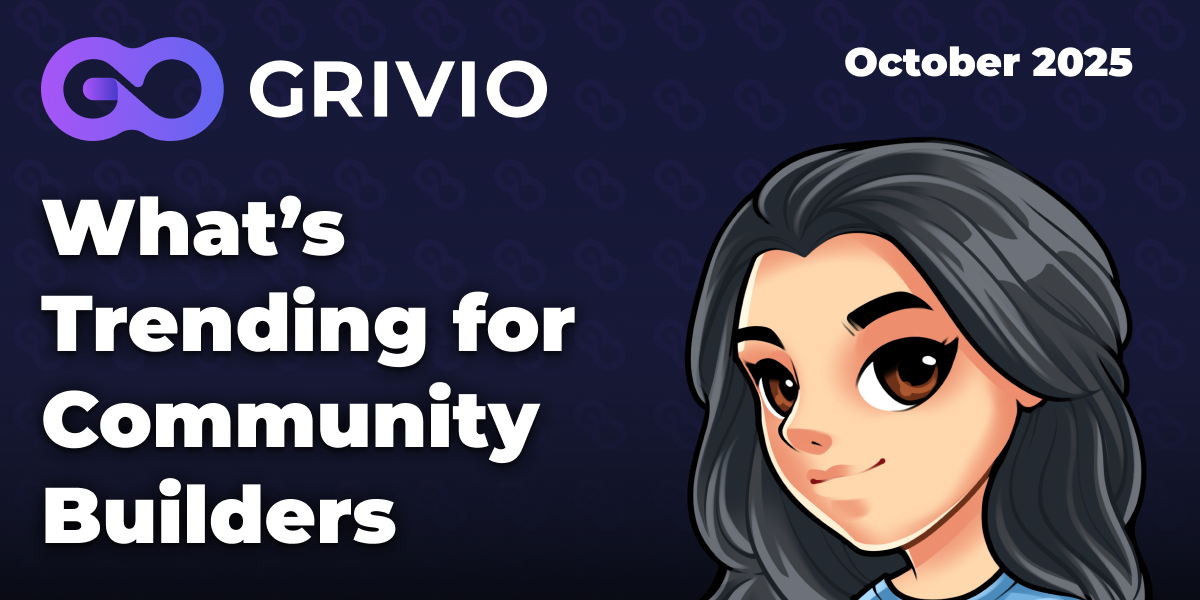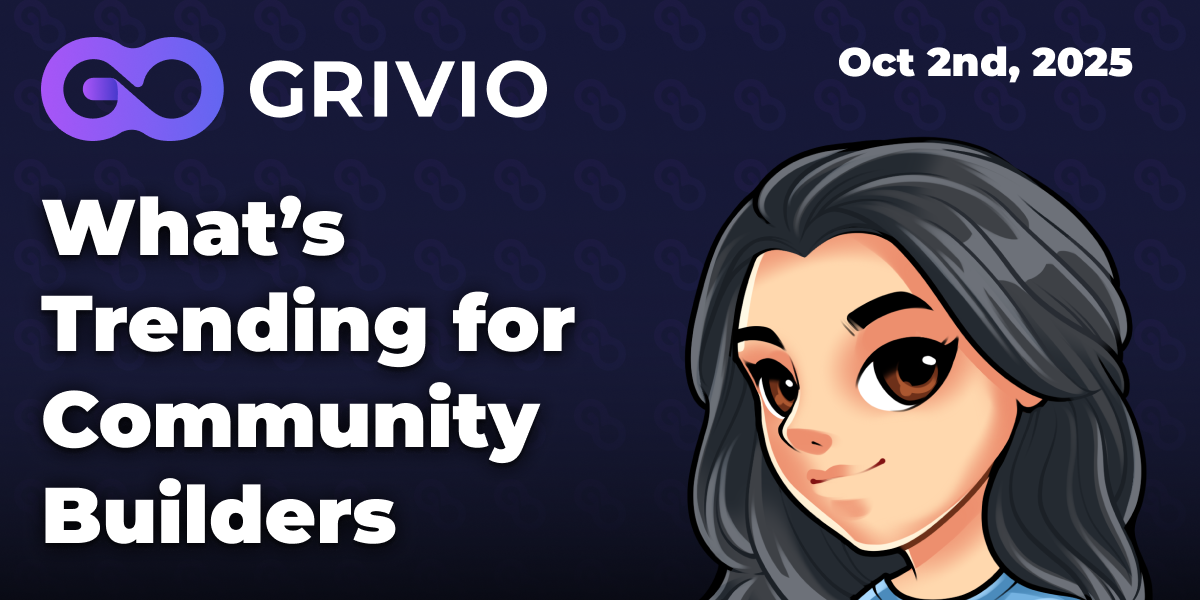What's Trending for Community Builders: When Halloween Hits Early!
shylor • October 2nd 2025

Grivio connects you with vibrant communities of Grivians who share your unique interests, no matter how niche.

November 22nd 2025

October 22nd 2025

May 23rd 2025
shylor • October 2nd 2025

Welcome to "What's Trending for Community Builders" with Claudia.
Every week, Claudia tracks emerging trends across online communities, spots opportunities you can act on, and connects cultural dots that matter to community builders like you.
Whether you're running a Discord server, building on Twitch, or managing communities across platforms, this is your weekly pulse check on what's actually happening - and what it means for your community.
Have you got feedback or spotted a trend we should cover? Let Claudia know.
Ever notice how your Discord goes quiet in early October, then suddenly explodes with horror content around the 20th? This year, something changed. The Halloween energy hit two weeks early, and smart community builders are already running their spookiest events. Dead by Daylight content surged to 291 million views on TikTok with 62,000 new posts in just one week. Silent Hill F sold a million copies in seven days, outpacing its own 2024 remake. The horror gaming community isn't waiting for Halloween—they're already here.
Here's why this matters, and what you should do about it.
The Horror Gaming Surge Came Early
Dead by Daylight is experiencing an unexpected revival moment. The game hit 291 million views on TikTok last week, driven by horror gaming edits, survivor strategy tips, and collaborative gameplay videos. This isn't just nostalgia—it's a community primed for pre-Halloween engagement finding its rhythm earlier than usual.
What makes this spike noteworthy is its timing. Typically, horror gaming content peaks in the final two weeks of October. This year, the surge began in mid-September and has sustained through the month. The content format has evolved too: instead of pure gameplay clips, creators are producing tutorial-style "survivor coaching" videos where experienced players teach newcomers specific strategies. This shift from entertainment to education signals a maturing community ready for deeper engagement.
Silent Hill F launched September 25th and immediately demonstrated the power of satisfying a long-neglected fanbase. The game sold over one million copies in its first week, outselling the 2024 Silent Hill remake that came before it. Community discussion exploded across Reddit's r/silenthill, with players praising the return to atmospheric psychological horror rather than action-heavy gameplay. Reviews specifically highlighted improved combat mechanics and the game's commitment to the franchise's original tone.
Dying Light: The Beast followed a similar pattern, receiving positive reception for its "crunchy gore combat" and survival-horror focus. Both games succeeded by delivering exactly what their core communities wanted, not by chasing broader market trends.
The Creator-Community Partnership Blueprint
Waterpark Simulator offers a glimpse into a new monetization model that community builders should watch closely. The developers partnered with Twitch streamer CaseOh, whose channel generated 1.2 million hours watched recently, to embed Easter eggs throughout the game using inside jokes from his community. When CaseOh discovered these references during a stream, the game experienced a 1,526% growth in Twitch viewership.
This wasn't accidental. The developers deliberately chose to validate a specific community's culture by making them co-creators in the content. The result was a powerful feedback loop: CaseOh's audience felt seen and included, which drove massive engagement, which attracted new players who wanted to understand the jokes, which grew both the streamer's community and the game's player base.
Memes That Stick: "Can't Prove It" Captures a Feeling
The "Can't Prove It" meme, featuring James Doakes from Dexter, went viral this week for perfectly capturing that gut-feeling suspicion when you know something's off but lack concrete evidence. The clip format is simple—Doakes saying "but you can't prove it"—but its application has been brilliantly diverse, from relationship humor to workplace dynamics to gaming accusations.
What makes this meme particularly useful for communities is its versatility and the fact that it references Dexter, which is experiencing renewed interest as Halloween approaches. The meme works across contexts, making it easy for different community types to adopt and adapt to their specific inside jokes.
Quick Win (2-3 Hours Setup): Horror Meme Contest
The "Can't Prove It" format is perfect for a rapid-engagement event. Host a contest where community members create their best community-specific version of the meme. Maybe it's "You said you'd read the rules... but you can't prove it" or "You're definitely lurking... but you can't prove it."
Provide a simple template, set a 48-hour submission window, and let members vote on the best entries. The winner gets a custom role or temporary server perks. This works because it's low-barrier (anyone can participate), time-bound (creates urgency), and reinforces community culture (inside jokes become more visible).
Expected engagement: 15-30% of active members will participate if promoted properly across your channels.
Medium Effort (1 Week Planning): Dead by Daylight Tournament
With Dead by Daylight's current momentum, now is the perfect time to host a community tournament or game night series. Structure it around skill tiers: beginners in one bracket, experienced players in another. This prevents new players from getting discouraged while giving veterans a competitive challenge.
Add a twist by theming roles around your community's personality. If you run a tech community, survivors could be "junior developers" trying to escape "legacy code monsters." If you're a creative community, make it about "artists escaping creative block demons." The game's collaborative format naturally encourages voice chat and team bonding.
Key detail: Partner with another similar-sized community for cross-pollination. You provide the survivors, they provide the killers, then switch. This introduces both communities to new potential members while creating natural networking opportunities.
Hard Mode (Ongoing Initiative): Build Your CaseOh Partnership
The Waterpark Simulator model requires more effort but offers the highest return: identify a creator whose community aligns with yours and explore collaboration opportunities. This doesn't mean you need to develop a video game—it means finding ways to validate and integrate their community's culture into your community's activities.
Start small. If you run a gaming community, reach out to a micro-influencer (5,000-20,000 followers) who shares your niche. Propose hosting a game night where their inside jokes become the event theme. Create custom Discord emotes based on their community memes. Feature their content in your channels while giving clear attribution.
The goal is creating that same feedback loop: their community feels recognized, your community gains exposure to engaged new members, and both communities grow through authentic cultural exchange rather than transactional promotion.
Seasonal Strategy: Fandom Validation Events
For communities focused on horror gaming specifically, now through Halloween is your moment. Host "deep dive" lore discussions for Silent Hill f—what does the Japanese setting add to the series' mythology? Create fan art contests themed around the game's specific aesthetic. Organize viewing parties for horror game playthroughs.
The key with fandom validation is focusing on what makes the fanbase passionate in the first place. For Silent Hill, that's atmosphere and psychological horror, not just jump scares. For Dying Light, it's the satisfaction of mastering survival mechanics. Your events should celebrate these core values rather than treating the games as generic entertainment.
Small communities (under 100 members): Host intimate lore discussion sessions where everyone can contribute. Create a shared Google Doc for collective theories.
Medium communities (100-500 members): Run structured tournaments with clear brackets and prizes. Feature member gameplay on a dedicated showcase channel.
Large communities (500+ members): Organize multi-week events with escalating challenges. Partner with other communities for cross-server competitions.
The early horror surge reveals what people need right now: "safe fear"—controlled spaces to experience danger without real consequences. Dead by Daylight's collaborative format creates emotional bonds through shared survival. When you barely escape with three friends, you've built a genuine memory.
This explains the survivor coaching boom. People aren't just consuming horror; they're seeking mastery through skill development. Communities providing structured paths from beginner to expert capture this energy.
The Waterpark Simulator partnership reveals a bigger shift. Communities aren't audiences anymore—they're creative partners. When developers embedded CaseOh's inside jokes into the game, his community felt ownership. That's fundamentally different from traditional fan dynamics.
Watch for more creator-community collaborations heading into 2025. Developers and creators realize engaged communities have valuable cultural capital. For community builders: cultivate your unique language and jokes, then reach out to creators in your space. An engaged audience with an established culture beats raw follower counts.
Meanwhile, traditional meme culture is fragmenting. The old Twitter-to-Reddit-to-Instagram pipeline is broken. TikTok dominates video, but cross-platform reach is harder.
This fragmentation is actually an opportunity. When centralized virality weakens, localized community culture becomes more valuable. Your inside jokes don't need to be viral everywhere—just deep resonance with your members. That loyalty survives algorithm changes.
The pattern across all these trends: successful community building in late 2025 requires dual-speed capability. Move fast on trending moments (Dead by Daylight tournament in 48 hours). Move slowly on authentic culture (let inside jokes emerge over months). Communities mastering this balance—quick on trends, patient with culture—will thrive past next year's Halloween.
Horror gaming stays strong through October, then likely dips for holiday content. The creator-partnership model keeps expanding. The "safe fear" insight applies beyond horror—people seek controlled spaces for strong emotions together. Whether horror, competition, or collaboration, communities providing structured emotional experiences win.
What's your community doing this week? Make sure members feel seen, included, and part of something bigger. That's where real community lives.